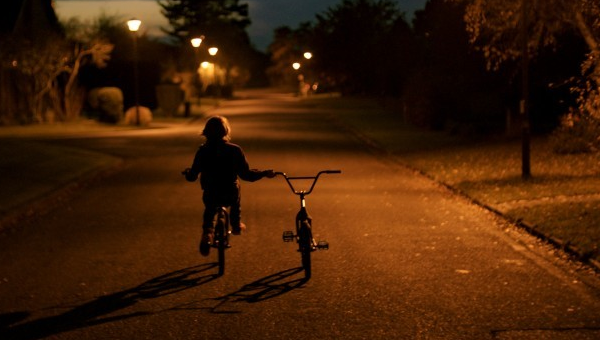 To capture the confused numbness that can envelop someone in the wake of a loss is an achievement. To capture it in a profoundly visual way is challenging. To do this in your first feature length film – as Bas Devos has done with VIOLET – is remarkable.
To capture the confused numbness that can envelop someone in the wake of a loss is an achievement. To capture it in a profoundly visual way is challenging. To do this in your first feature length film – as Bas Devos has done with VIOLET – is remarkable.
Fifteen-year-old Jesse (Cesar De Sutter) has witnessed the stabbing of his friend Jonas in the local shopping mall. The seemingly motiveless murder is captured on CCTV as the film opens, panning back to reveal a bank of monitors and the slightest glimpse of a watching security guard. From then on, we closely follow Jesse as he attempts to reintegrate into his BMX biker group, and get on with his daily life.
The first shot of Jesse, after the murder, is an extreme close up: he’s caked with blood, in shallow focus. Shot in Academy ratio, the visual style of the film itself encourages the viewer to scrutinise Jesse, in the way he feels scrutinised by the people around him. Blank and expressionless, Jesse’s face gives nothing away. Why was he spared? No one really knows.
Shot in Academy ratio, the visual style of the film itself encourages the viewer to scrutinise Jesse…
Although Devos’ construction of the film and visual sensibilities are what drive this sense of inscrutability and unheard internal dialogue, De Sutter’s performance supports his director extremely well. Although visually central to the group as he coasts about with his BMX companions, he is devoid of joy or exuberance, not engaging in the tricks and flourishes of the other riders. Jesse’s ride is the BMX equivalent of sleepwalking.

The undercurrent of judgment from his peers eventually starts to fray Jesse, but the subdued tone means that when more explicit moments come, they connect like a punch to the gut: “In my eyes, you’re a coward,” exclaims one boy at a forest BMX track. It is not until later that the flatness of Jesse’s own demeanour cracks slightly. There is a sense that while only one boy died in the mall, the other has not truly returned yet.
There is a brutal reality to much of the texture Davos brings when not focusing on De Sutter: flowers and bears left for Jonas being scooped up by rakes, from a blood-like compost sludge; dogs ripping apart rubbish bags on Jesse’s street. Even a shot of bikers whipping sharply around a right turn (the course just out of frame) has a violent edge to it.
Even a shot of bikers whipping sharply around a right turn has a violent edge to it.
The still-life imagery of the rest of the film often has a calm beauty. Dust falling through light streaks around Jesse’s trainers; sparks dart above the bikers’ heads. Although a film primarily concerned with the presence or absence of outward emotions, Devos finds spaces to illustrate the film with these artistic compositions.
The small section of the film shot on 65mm looks superb, and the rest of the digitally shot scenes have a more vibrant appearance than one might have come to expect from the format; the aspect ratio emphasising Jesse’s shut-off mindset. This is perhaps in no small part due to Devos’ collaboration with cinematographer Nicolas Karakatsanis, whose work on BULLHEAD was equally effective.
A long and remarkable closing shot summarises the film nicely in many ways: a slow and deliberate journey, thoughtfully composed with a sense of underlying torment, disappearing into a cloud of grief. The visual style of VIOLET constantly reminds us that we can’t get inside Jesse’s head, as much as we would like to.
httpvh://www.youtube.com/watch?v=c_nMy7UJneo

